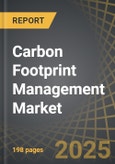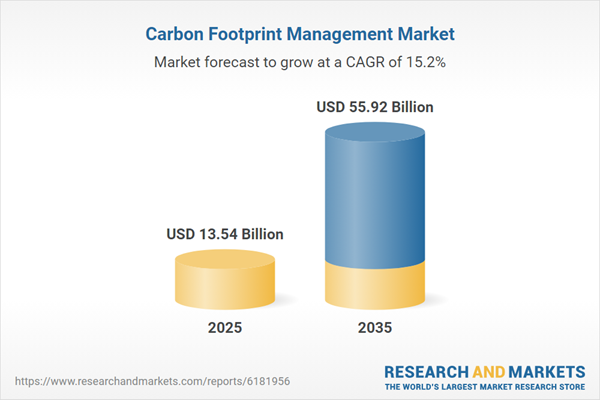CARBON FOOTPRINT MANAGEMENT MARKET: GROWTH AND TRENDS
The term "carbon footprint" refers to the overall quantity of greenhouse gases produced by everyday human activities. Through the use of technology, this can be managed with advanced software and tools designed for measuring carbon footprints. These management solutions encompass tracking, reducing, and offsetting greenhouse gas emissions. Additionally, these comprehensive solutions help businesses, governments, and individuals participate in combating climate change by establishing reduction targets, implementing strategies, and monitoring as well as reporting on progress.Consequently, the market for carbon footprint management is experiencing significant growth worldwide. A report from the UN indicates that approximately 107 countries, responsible for about 82% of greenhouse gas emissions, have committed to net-zero targets either through legislation or policies, such as national climate action plans.
This is largely because government policies have a considerable impact on carbon emissions; regulations and incentives can lead to reductions by promoting renewable energy, imposing emission standards, and fostering sustainable practices across various industries. Additionally, the UN Environmental Program (UNEP) suggests that nations should aim to reduce greenhouse gas emissions by 42% by the year 2030.
As a result, governments are implementing climate change mitigation strategies to achieve these objectives, indicating a focus on managing greenhouse gas emissions. Moreover, the increasing emphasis on the integration of technology, including digital tools and AI for carbon tracking, as well as the rising demand for carbon accounting services, are key drivers for the growth of carbon footprint management market during the forecast period.
CARBON FOOTPRINT MANAGEMENT MARKET: KEY SEGMENTS
Market Share by Type of Component
Based on type of component, the global carbon footprint management market is segmented into solutions and service. According to our estimates, currently, the service segment captures the majority share of the market. This can be attributed to the increasing demand for consulting training alongside the need for cost-effective operational and implementation support.However, the solutions segment is expected to grow at a relatively higher CAGR during the forecast period. This growth can be attributed to fact that these tools assist organizations in efficiently monitoring, analyzing, and reporting their carbon emissions. Additionally, software solutions facilitate real-time emissions tracking across different operations, offering valuable insights for minimizing carbon emissions and aiding in compliance with regulatory reporting requirements.
Market Share by Type of Deployment
Based on type of deployment, the carbon footprint management market is segmented into cloud and on-premises. According to our estimates, currently, lithium captures the majority of the market. Additionally, this segment is likely to grow at a higher CAGR during the forecast period. This can be attributed to the widespread adoption of cloud-based carbon footprint management software and services.These solutions offer secure and cost-effective tools for tracking carbon emissions and reliable support. Further, their flexibility, scalability, and ease of implementation is fueling the expansion of this market
Market Share by Organization Size
Based on organization size, the carbon footprint management market is segmented into corporate enterprises, mid-tier enterprises, and small businesses. According to our estimates, currently, corporate enterprise segment captures the majority share of the market. This can be attributed to their complicated operations, extensive emissions, and growing demands from investors. Carbon management solutions are essential for their operations in fulfilling ESG requirements.However, small businesses segment is expected to experience the highest compound annual growth rate (CAGR) during the forecast period, owing to the strict regulatory compliance and government pressure that urge companies to invest in carbon offset initiatives and adopt effective practices for minimizing carbon emissions.
Market Share by Type of Vertical
Based on type of vertical, the carbon footprint management market is segmented into energy utilities, financial services, government, IT and telecom, manufacturing, residential and commercial buildings, and transportation and logistics. According to our estimates, currently, energy and utilities segment captures the majority share of the market. However, the manufacturing sector is expected to grow at a higher compound annual growth rate (CAGR) during the forecast period.Market Share by Geographical Regions
Based on geographical regions, the carbon footprint management market is segmented into North America, Europe, Asia, Latin America, Middle East and North Africa, and the rest of the world. According to our estimates, currently, North America captures the majority share of the market. However, the market in Asia is expected to grow at a higher compound annual growth rate (CAGR) during the forecast period. This can be attributed to the rapid industrial development and urbanization in the region, which have resulted in high carbon emissions. To mitigate emissions, developing nations are increasingly investing in carbon footprint management solutions and services.CARBON FOOTPRINT MANAGEMENT MARKET: RESEARCH COVERAGE
The report on the carbon footprint management market features insights on various sections, including:- Market Sizing and Opportunity Analysis: An in-depth analysis of the carbon footprint management market, focusing on key market segments, including [A] type of component, [B] type of deployment, [C] organization size, [D] type of vertical, and [E] geographical regions.
- Competitive Landscape: A comprehensive analysis of the companies engaged in the carbon footprint management market, based on several relevant parameters, such as [A] year of establishment, [B] company size, [C] location of headquarters and [D] ownership structure.
- Company Profiles: Elaborate profiles of prominent players engaged in the carbon footprint management market, providing details on [A] location of headquarters, [B] company size, [C] company mission, [D] company footprint, [E] management team, [F] contact details, [G] financial information, [H] operating business segments, [I] service / product portfolio, [J] moat analysis, [K] recent developments, and an informed future outlook.
- Megatrends: An evaluation of ongoing megatrends in the carbon footprint management industry.
- Patent Analysis: An insightful analysis of patents filed / granted in the carbon footprint management domain, based on relevant parameters, including [A] type of patent, [B] patent publication year, [C] patent age and [D] leading players.
- Recent Developments: An overview of the recent developments made in the carbon footprint management market, along with analysis based on relevant parameters, including [A] year of initiative, [B] type of initiative, [C] geographical distribution and [D] most active players.
- Porter’s Five Forces Analysis: An analysis of five competitive forces prevailing in the carbon footprint management market, including threats of new entrants, bargaining power of buyers, bargaining power of suppliers, threats of substitute products and rivalry among existing competitors.
- SWOT Analysis: An insightful SWOT framework, highlighting the strengths, weaknesses, opportunities and threats in the domain. Additionally, it provides Harvey ball analysis, highlighting the relative impact of each SWOT parameter.
- Value Chain Analysis: A comprehensive analysis of the value chain, providing information on the different phases and stakeholders involved in the carbon footprint management domain.
KEY QUESTIONS ANSWERED IN THIS REPORT
- How many companies are currently engaged in carbon footprint management market?
- Which are the leading companies in this market?
- What factors are likely to influence the evolution of this market?
- What is the current and future market size?
- What is the CAGR of this market?
- How is the current and future market opportunity likely to be distributed across key market segments?
REASONS TO BUY THIS REPORT
- The report provides a comprehensive market analysis, offering detailed revenue projections of the overall market and its specific sub-segments. This information is valuable to both established market leaders and emerging entrants.
- Stakeholders can leverage the report to gain a deeper understanding of the competitive dynamics within the market. By analyzing the competitive landscape, businesses can make informed decisions to optimize their market positioning and develop effective go-to-market strategies.
- The report offers stakeholders a comprehensive overview of the market, including key drivers, barriers, opportunities, and challenges. This information empowers stakeholders to stay abreast of market trends and make data-driven decisions to capitalize on growth prospects.
ADDITIONAL BENEFITS
- Complimentary Excel Data Packs for all analytical modules in the report
- 15% free content customization
- Detailed report walkthrough session with the research team
- Free report update available for reports older than 6 months
Table of Contents
Companies Mentioned (Partial List)
A selection of companies mentioned in this report includes, but is not limited to:
- Accuvio
- Carbon Footprint
- Carbon Trust
- Dakota Software
- Eco Tack
- Enablon
- EnergyCap
- ENGIE
- Enviance
- Envirsoft
- ESP
- IBM
- Intelex
- Isometrix
- Locus Technologies
- NativeEnergy
- ProcessMap
- Salesforce
- SAP
- Schneider
- Trinity
Methodology

LOADING...
Table Information
| Report Attribute | Details |
|---|---|
| No. of Pages | 198 |
| Published | October 2025 |
| Forecast Period | 2025 - 2035 |
| Estimated Market Value ( USD | $ 13.54 Billion |
| Forecasted Market Value ( USD | $ 55.92 Billion |
| Compound Annual Growth Rate | 15.2% |
| Regions Covered | Global |









